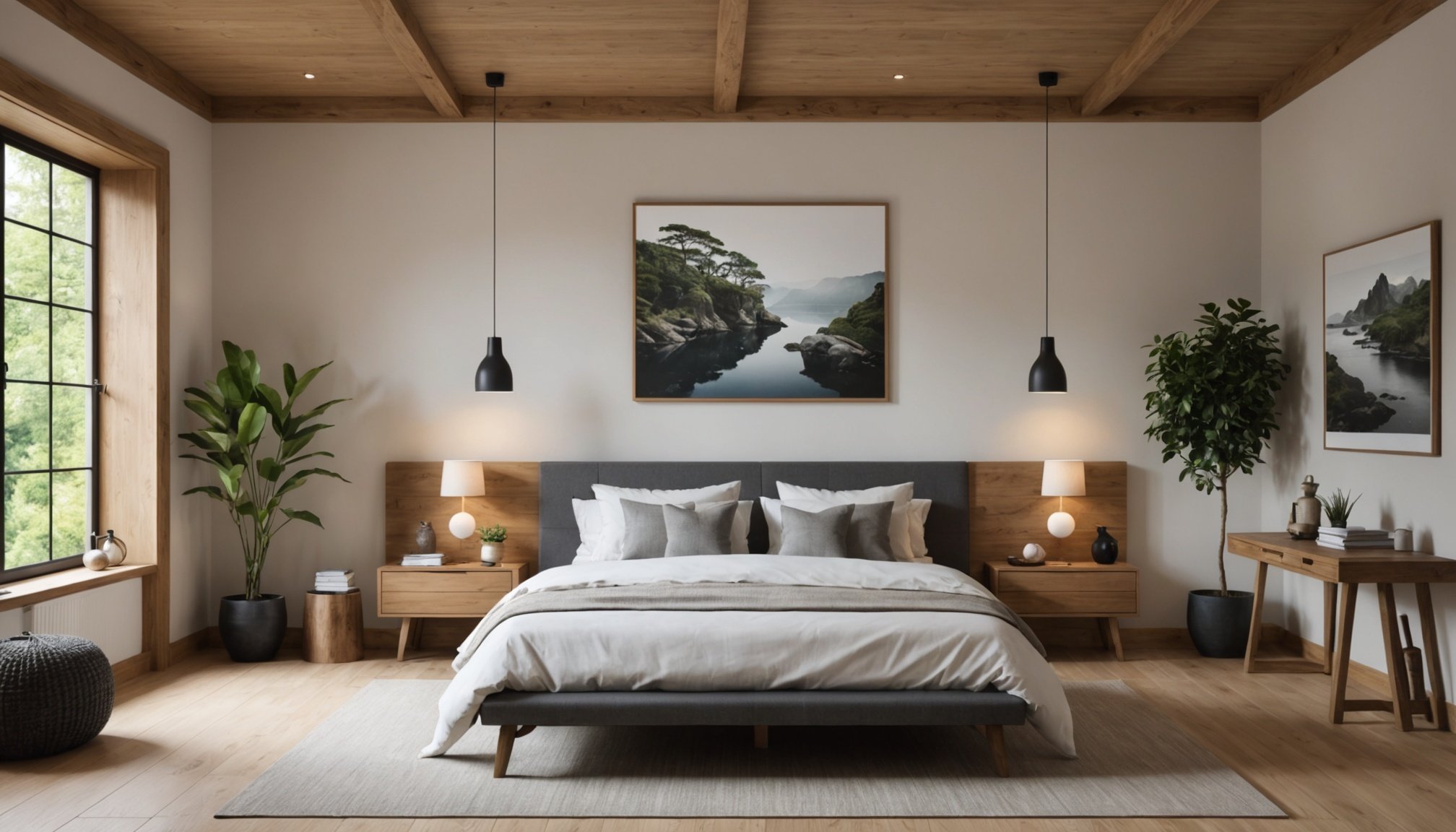Understanding Zen Design Principles
Delving into Zen design principles unveils a world where simplicity meets purpose. At the heart of this philosophy lies the idea of fostering a serene environment through minimalist aesthetics. By paring down to the essentials, spaces become inherently calming, aiding one’s pursuit of tranquility.
Minimalism plays a pivotal role, as a clutter-free setting reduces visual distraction. This approach embodies the Zen ideal of ‘less is more’, promoting an atmosphere where the mind can find stillness. The emphasis is on function, with each element serving a clear purpose, aligning with the broader Zen ethos.
A lire également : Maximize Your Space: Creative Storage Solutions for Small UK Flats
To further enhance this serenity, the integration of natural elements is essential. Incorporating materials such as wood, bamboo, and stone not only complements the minimalist framework but also fosters connection to the earth. Such elements bring warmth and organic texture, aligning with the Zen value of harmony with nature.
In practice, embracing Zen design principles means creating spaces that encourage mindfulness and reflection. Consider soft, neutral colour palettes and natural light to further embody a sense of peace. Through these techniques, an interior transforms into a sanctuary, conducive to relaxation and introspection. By understanding and implementing these core tenets, your environment can mirror the tranquility sought by Zen philosophy.
Cela peut vous intéresser : Essential Insights for Seamlessly Adding a Mezzanine to Your UK Loft Conversion
Color Schemes for a Zen Bedroom
Choosing the right Zen color palette can transform your bedroom into a sanctuary of peace. Calming colors such as soft blues, greens, and neutrals are highly recommended. They promote relaxation and help in creating a tranquil atmosphere. These colors are reminiscent of nature, which inherently induces a sense of calm.
Psychologically, certain bedroom colors can affect your mood. Soft blues are often associated with serenity, while greens bring a sense of balance and renewal. Neutrals like beige or soft gray can create a harmonious backdrop, allowing other elements of your decor to stand out subtly.
Incorporating natural light plays a crucial role in enhancing these colors’ effectiveness. Natural light can make colors appear more vibrant and help in elevating the mood of the room. Large windows or sheer curtains can maximize natural light exposure, ensuring that the calming colors are highlighted throughout the day.
To further enhance the Zen experience, consider layering textures with your chosen color scheme. Textural contrasts in bedding or rugs, while keeping to the calming color theme, can add depth and a touch of elegance without disrupting the peaceful ambiance.
Furniture Selection for Tranquility
Creating a harmonious space begins with selecting the right Zen furniture. Such pieces often embrace simplicity and functionality, promoting a sense of serenity. A primary characteristic of minimalist furniture is its uncluttered design, often reflecting nature’s elegance. Opt for items with clean lines and a neutral colour palette, facilitating a calm and peaceful environment. Consider incorporating a low-profile coffee table and a sleek sofa to embody these principles.
The choice of materials also plays a crucial role. Using natural materials, like wood, bamboo, or stone, can deeply connect your interior with the natural world, enhancing tranquility. These materials not only bring warmth and earthiness but also contribute to an eco-friendly lifestyle, which aligns with Zen philosophy.
To cultivate spaciousness, thoughtful furniture arrangement is imperative. Prioritise open spaces by limiting furniture. Position seating to face doors and windows, encouraging natural light to fill the room. Avoid blocking sightlines with large objects. Instead, employ plants or minimalist art to subtly accentuate the room without overcrowding. By embracing these strategies, you’ll cultivate a sanctuary that embodies the essence of Zen. With careful selection and arrangement, it’s possible to transform any living space into a peaceful retreat.
Decorative Elements that Enhance Serenity
Embracing Zen decoration can create a peaceful atmosphere in any space. To achieve a Zen-inspired look, incorporating essential decor items is key. Minimalist accessories such as simple vases, stones, or small plants can contribute to this calming decor. Each piece should be thoughtfully chosen to ensure it serves a purpose and blends harmoniously with the surroundings.
Art and textiles are also crucial in fostering tranquility. Soft, neutral colours and natural materials like linen or cotton work best. Consider hanging artwork with serene themes or displaying Japanese caligraphy to infuse the space with Zen culture. This approach enables the room to speak through its design, inviting calmness and reflection.
Decluttering is an integral part of Zen decoration. Keeping your surroundings tidy and minimal reduces distractions, allowing for a tranquil, focused atmosphere. The philosophy promotes the idea that a cluttered environment leads to a cluttered mind; maintaining simplicity in the decor cultivates mental peace.
Incorporating these elements into your home encourages serenity and focus, turning any space into a peaceful retreat. Seek harmony in your arrangements, and let the essence of Zen transform your living area into a sanctuary of calm.
Layout Tips for Optimal Zen Flow
Creating a Zen layout in your bedroom involves more than just aesthetics; it’s about fostering a peaceful and harmonious space. Start by considering the space flow within the room. Arranging furniture to allow easy movement enhances functionality and reduces stress, contributing to your overall well-being. Prioritise a clutter-free environment, as this encourages positive energy circulation.
To optimise energy flow, place larger furniture pieces like beds and wardrobes against walls, leaving open pathways. In Zen philosophy, symmetry and balance play key roles. Position your bed centrally or against a solid wall with a clear view of the door, considered a commanding position in feng shui. This placement provides a sense of security and enhances relaxation.
A serene bedroom layout also involves thoughtful selection of materials and textures. Natural materials such as wood and soft textiles foster warmth and tranquillity. Integrate plants or natural elements to further promote calmness and connection with nature, enhancing the peaceful atmosphere you desire.
Ultimately, the goal is to create a sanctuary that soothes the mind and body. By achieving a balance of function and tranquillity, your bedroom can become a personal retreat, radiating serenity and inviting relaxation.
Incorporating Natural Elements
Incorporating natural materials and indoor plants into your bedroom can transform it into a serene haven. The introduction of plants not only enhances air quality by purifying pollutants, but also adds a vibrant, living aesthetic. Consider varieties like snake plants or spider plants, which are particularly adept at improving indoor air.
Natural materials in decor, such as wood, stone, or linen, provide a grounding and minimalist touch. For instance, a wooden bed frame or a stone accent wall can offer a warm and rustic atmosphere. Similarly, linen curtains or cotton bedspreads imbue the room with a soft, airy feeling.
To create a seamless blend between the indoors and outdoors, consider the use of large windows or glass doors that afford expansive views of nature. This technique enhances natural light and provides visual continuity with the surrounding landscape, fostering a sense of tranquillity and openness.
Additionally, nature-inspired decor such as floral patterns or botanical prints can subtly echo the vibrancy of the outdoors. Incorporating these elements encourages a relaxing retreat that harmonizes both comfort and eco-friendliness, making your bedroom an ideal refuge from daily stressors.
Mindful Practices to Enhance Relaxation
Enhancing relaxation through mindfulness can be both fulfilling and transformative. It all begins with incorporating simple mindfulness exercises in the bedroom. These exercises might include deep breathing, consciously closing your day with a gratitude practice, or taking five minutes to focus your mind on a single calming thought. These practices serve as profound relaxation techniques and can significantly improve your evening routine.
Creating a meditation space or corner in your bedroom can promote a peaceful atmosphere. Choose a quiet spot and equip it with comforting items like soft cushions or calming colours. This space acts as a physical reminder to prioritise mindfulness and engage in regular meditation, grounding you in moments of stress or restlessness.
Aligning your bedtime routine with Zen principles can also enhance relaxation. This might involve warming the room with dim lighting, playing soft music, and practising mindful breathing to transition from the day’s hustle to a serene night’s rest. Over time, these practices facilitate a sense of calm and improved quality of sleep, ensuring that relaxation becomes a natural part of your daily rhythm. These practices can foster calm and encourage mindfulness, making relaxation a consistent and welcomed part of life.











